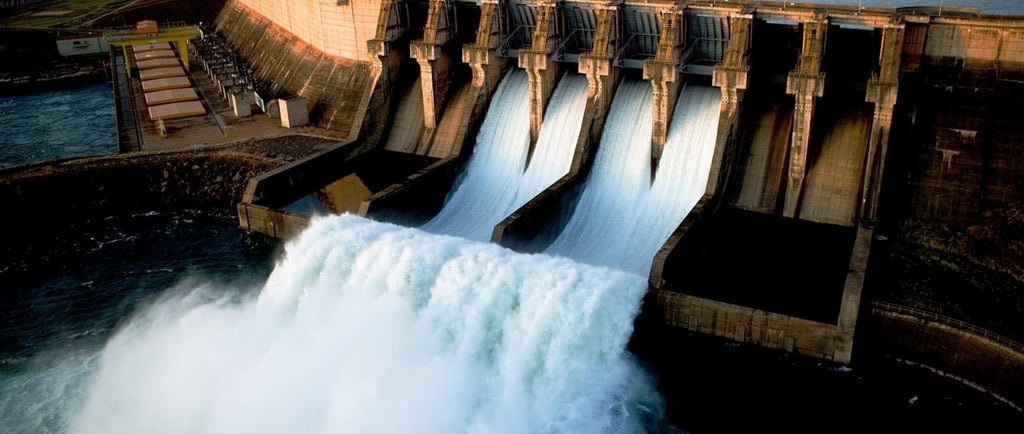Hydropower in Sub-Saharan Africa: Impact of Climate Change and Escalating Conflicts on Shared Water Resources
Atef Mahmoud Dabal – Political Science Researcher
8/27/20253 min read


Hydropower is the backbone of Sub-Saharan Africa's electricity supply. In many nations across the region, it’s not just a source of energy—it’s the source of energy, powering homes, schools, and industries. But this deep reliance on rivers is becoming a critical vulnerability. A perfect storm of climate change, aging infrastructure, and escalating conflicts over shared water resources is threatening to turn this vital asset into a major liability.
As droughts intensify and rainfall patterns become more erratic, the very systems designed to power Africa's future are at risk. This isn't a distant threat; it’s a gathering crisis that demands a fundamental rethink of the continent's energy strategy.
A System Under Strain: Africa's Hydropower Dilemma
Hydropower provides about 40% of Sub-Saharan Africa's electricity, and in some countries, that figure climbs to over 90%. This reliance on a renewable resource has been a cornerstone of development. But the system is showing its age. A staggering 60% of Africa's hydropower plants are over 20 years old, with many in urgent need of upgrades.
This aging infrastructure is now facing a new and powerful adversary: climate change. Projections show a future of increasing extremes:
Intensifying Droughts: Southern Africa is expected to see a sharp decrease in rainfall, while the Horn of Africa has already endured its longest drought on record.
Erratic Rainfall: Across the continent, rainfall is becoming more intense but less frequent, leading to cycles of devastating floods and prolonged dry spells.
Rising Temperatures: Higher temperatures mean greater evaporation from reservoirs, reducing the amount of water available to generate power.
For the 160 million people who depend on hydropower-dominant grids, these changes translate directly into a less reliable and more fragile energy supply.
The "Infrastructure Trap": Building for a Bygone Climate
Despite these clear and present dangers, Africa is planning a massive expansion of hydropower, with over 80 GW of new capacity in the pipeline. But there’s a critical flaw in this strategy: many of these multi-billion-dollar projects are being designed based on historical rainfall data from decades ago—data that is increasingly irrelevant in our rapidly changing climate.
This creates what experts call the "infrastructure trap." By investing billions in new dams built for a climate that no longer exists, the region risks locking itself into a cycle of vulnerability. Instead of building resilience, limited financial resources are repeatedly diverted to repairing and rebuilding assets damaged by climate shocks, stalling economic growth and trapping nations in a state of perpetual crisis.
A Conflict Multiplier: The Case of the Grand Ethiopian Renaissance Dam (GERD)
Nowhere are the stakes higher than in the Nile Basin. The Grand Ethiopian Renaissance Dam (GERD), a mega-project at the heart of Ethiopia's development ambitions, has become a focal point of intense geopolitical tension with downstream Egypt and Sudan.
Climate change is acting as a "conflict multiplier" in this already volatile situation. With future rainfall patterns in the Nile Basin highly uncertain, concerns over water scarcity are escalating. Uncoordinated dam operations during a multi-year drought could have catastrophic consequences for the tens of millions who depend on the Nile's flow. Climate-induced water stress is turning a dispute over a dam into a potential trigger for broader regional instability, highlighting the urgent need for robust, legally binding agreements on shared water management.
Forging a Resilient Future: A New Energy Blueprint for Africa
Navigating this complex crisis requires a paradigm shift in how Africa plans, finances, and manages its energy systems. A resilient future must be built on a foundation of diversification, innovation, and cooperation.
1. Diversify, Diversify, Diversify
The over-reliance on hydropower is a vulnerability that can no longer be ignored. Africa is blessed with some of the world's best solar and wind resources, yet it has barely scratched the surface of this potential. Solar is already the cheapest source of new electricity in many parts of the continent. Integrating solar and wind with hydropower can create a powerful synergy, with dams providing storage to balance the intermittency of renewables, ensuring a stable and reliable grid.
2. Climate-Proof the Infrastructure
All new energy projects must be designed with the future climate in mind. This means moving beyond outdated historical data and integrating climate risk into every stage of planning, from dam design to grid upgrades. Proactive climate-proofing is far more cost-effective than reactive repairs.
3. Strengthen Regional Cooperation
Over 90% of Africa's surface water crosses national borders. In an era of increasing water stress, transboundary cooperation is not a choice; it is a necessity. Sharing data, coordinating dam operations, and developing joint adaptation strategies can turn shared resources from a source of conflict into a catalyst for collective security and prosperity.
4. Close the Climate Finance Gap
Africa contributes less than 4% of global greenhouse gas emissions yet suffers disproportionately from its impacts. The region receives a mere 3% of global climate finance, a staggering injustice that hobbles its ability to adapt. Wealthy nations must honor their commitments and provide the financial support needed to build a resilient and sustainable energy future for the continent.
The challenge is immense, but so is the opportunity. By embracing a diversified, climate-resilient energy strategy, Sub-Saharan Africa can not only navigate the looming water crisis but also leapfrog into a new era of clean, sustainable development. The time to act is now.
Download the full study here.
Empowerment
Amplifying African voices for sustainable progress together.
Contact US
Growth
Street No. 3281, N'Djamena, Republic of Chad.
© 2024. All rights reserved.